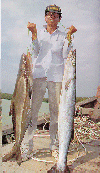
About Sport Fish you will find in our sunny tropical paradise
 |
Local Fish
About Sport Fish you will find in our sunny tropical paradise |
 Barracuda
Barracuda
Sphyraena Barracuda a.k.a. Sea pike, kacang-kacang, alu-alu, tenak This fish is one real chomper! It has a ravenous appetite! Lures, livebait, dead bait, it eats every thing! As it is relatively common, it often save a quiet fishing trip from boredom. It is one pelagic fish we always catch on a sea fishing trip! Always? Well, almost always. Unlike the narrow-barred spanish mackerel it can be found inshore and offshore, even in slightly murky waters. Like any predatory fish, it is found around coral reefs, estuaries and rocky shorelines, anywhere bait fish can be found. It is well equipped with large hard scales for protection, to hunt in these sharp edged areas. Other places like buoys, current lines and even the rubbish lines near river mouths have barracuda hanging around looking for a meal of fish. Frequently while bottom fishing, upon hooking up a fish and bringing it up struggling, there will be a massive tug, and the reel screams! For a moment the line peels off, then the line goes slack. Either the hooked fish has been bitten in half or the whole fish taken into the barracuda's mouth and the main line bitten through. Quite a common occurrence it can be a nuisance at times. The barracuda is cannibalistic, armed with a nice set of sharp teeth. It can neatly chomp a fish as large as itself neatly in half! Having a bigger barracuda "slicing" the barracuda on your line in half is not unusual! Spanish mackerel like to do this too. Barracuda can be quite good jumpers on occasions and provide quite a few thrills! Sometimes these jumps enable the barracuda to throw the hook, especially for those poorly hooked up. The barracuda are a schooling fish and having multiple hook ups while trolling is common, but the really large ones above 20kgs or so tend to be loners. The average size normally caught is 5kgs to 15kgs. Trolling with diving lures, high speed bibless lures and skirts all work. One just has to figure out what they are taking that day. Sometimes the skirted lure can be more effective, but the most common lure used is the bibbed lure. The normal livebaits are very effective. Naturally the use of wire leaders is a must! The use of floating rigs to place live baits just below the surface during the night or day is very effective. Placing live baits at mid-water or near the bottom is effective too. It all depends on the location and other conditions. Live baiting at night seems to get more bites than during the day. During one rough and windy trip, we were anchored in a bay and we actually ran out of live bait. The barracuda kept hitting the live bait. There seemed to be a lot of barracuda around that night. As the wind kept changing and the boat kept swinging around, I had problems with my line getting tangled up with the other anglers' lines at the transom as I was fishing from the front of the boat. I got fed up and wound up my line, leaving the live bait dangling 5 feet beneath the boat. Thirty minutes later, I reeled in the line as we were about to retrieve the anchor to get under way. Surprisingly the line was suddenly pulled out. After a short tussle I landed a barracuda. It had taken the live bait just under the boat and remained there without running off. I have seen them do this quite often. One can often have the live bait out for ages, and only discover that there is a barracuda on the line when retrieving the bait. On one trip, at about midnight, I had this feeling that there was a barracuda lurking around. Feeling rather "crazy" I decided to drift out a live bait on my light baitcasting gear, spooled up with 6lb line. It took only 10 minutes before the live bait was taken! I quickly set the hook and was rewarded with a strong 5 minute fight from a 4lb barracuda that dived deep down, due to the thin 6lb line providing less resistance to the barracuda. It therefore spent more effort fighting the angler than a thick line. However, there have been times when we have trolled around a specific spot for an hour, with no results. Then we anchored to live bait, with the same negative results. But when a todak was hooked up and brought struggling boat side, we suddenly saw 2 dark and sleek shapes following the hooked up todak to the boat. We left the todak struggling and splashing beside the boat and we saw two yellow tailed barracuda surface to take a look at the helpless todak. Then they just disappeared, obviously just curious, not hungry. There are a few types of barracuda commonly found in our waters, distinguished by having a dark grey/black tail or a yellowish tail. Generally the barracuda with the yellow tail has better quality flesh (smoother) than the black tailed barracuda. But the dark tailed one is normally a Great Barracuda, the largest of them all. |